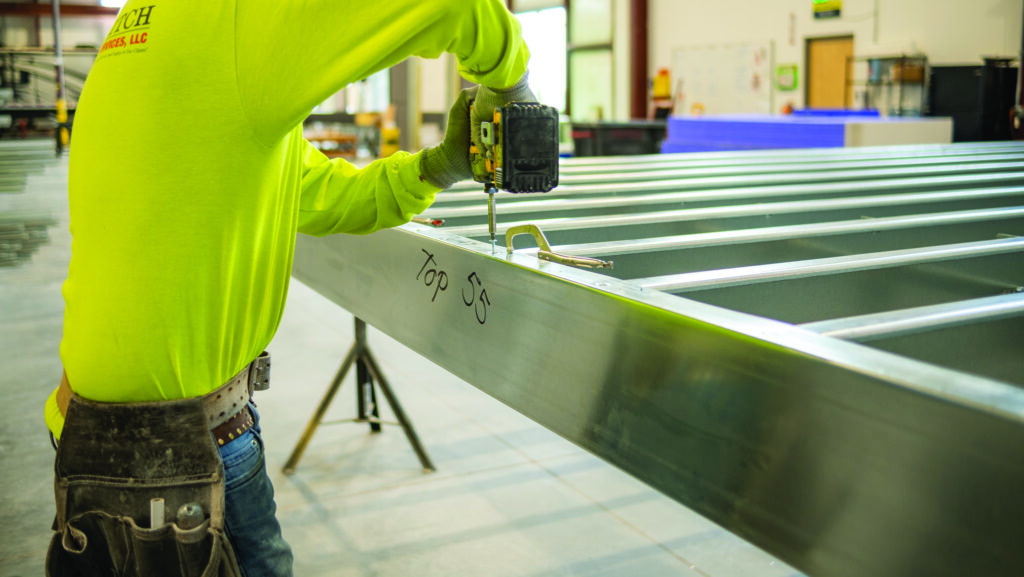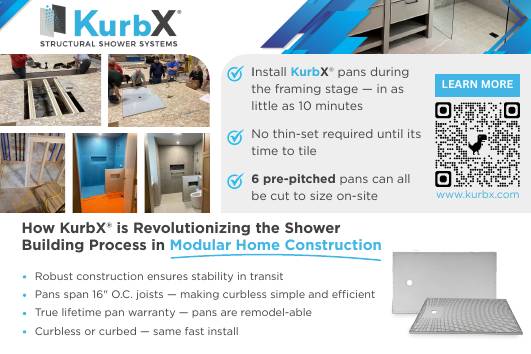This general contractor decided to use prefabricated components for both interior and exterior walls in a new health clinic.
- Because this was a design-build project, the contractor was able to optimize it for a full-panel approach that included interior as well as exterior walls.
- Exterior panels reduced shell framing time from 28 days to five days, while the interior panels meant that drywall could be hung 30% earlier. There was also a $250,000 material savings.
- The contractor stresses the need to familiarize subs with the panel approach.
Regional healthcare network Catholic Health Initiatives (CHI Health) is headquartered in Omaha, Nebraska, and has facilities in the surrounding states. CHI Health is adding to its facilities this summer (2024) with a new 40,000 sq. ft. Immanuel Medical Center Family Clinic in north Omaha.
The design-build team of McCarthy Building Companies (McCarthy) and Hoefer Welker used prefabricated components for interior and exterior wall assemblies. This led to a dramatic savings of time and money.

Credit: Deleted Scene Production Company
Project Background
Before bidding on the single-story steel structure outpatient clinic, McCarthy didn’t insist on prefab. “We recommended it as a way to maximize efficiency, but didn’t dictate it when we put the project out to bid,” says Virgil Pope, a Senior Project Manager with McCarthy who is serving as the project lead. The contractor who won the bid, Falewitch Construction Services, was on board with the prefab approach.
McCarthy recommended using prefab for multiple reasons, according to Kris Montgomery, the Nebraska market leader for McCarthy. They include:
- Ongoing labor shortages in the industry
- Improved safety
- Outside influences such as weather
He adds, “It’s also more cost efficient. Our clients are always looking for ways to save money, and we as an organization are always trying to add value for our customers.”

Credit: Deleted Scene Production Company
The Right Circumstances
Most of the building’s walls – interior and exterior – utilized prefab materials.
- 95% of exterior walls, including framing, sheathing, air and weather barriers
- 75% of interior walls, including in-wall electrical rough-ins and backing
- Prefab mechanical and plumbing racks
While McCarthy’s Nebraska team has utilized prefab materials in the past, this is the furthest they’ve progressed in terms of interior walls. A few reasons empowered McCarthy to go further with prefabrication on this project.
One reason was that because the outpatient clinic was a design-build project, the team was able to make design decisions. While there was a lot of coordination and collaboration with the owner, the structure and design were driven by McCarthy.
“As the team got 30% into the design phase, conversations about including prefab came up,” Montgomery says. “Some elements of prefab drove some design decisions.”
The clinic includes 64 exam rooms, a radiology suite, a procedure room and a pharmacy. All exam rooms are laid out exactly the same way. Typically, plumbing is on one wall between two rooms to save money.
In this case, the design-build team decided to have sinks on the left side (upon entering) of the exam room. “This setup is less efficient [due to extra infrastructure] from a plumbing standpoint, but the prefab savings absorbed the extra cost,” Montgomery says. “As an added benefit, the same room setup enables CHI Health to more efficiently train their staff because every room is configured in the same way.”
Pope adds, “This is one of the benefits of design-build; the team was able to consider constructability vs. design.”

Credit: Deleted Scene Production Company
Dramatic Savings
Turning to prefab construction led the team to realize significant savings when compared to site building.
- 60% faster completion of building enclosure
- 30% faster from start to finish of interior framing
- 6% construction cost savings over traditional construction approach
These types of eye-popping savings are often talked about by offsite construction enthusiasts, yet are not always realized. “To maximize savings, you have to focus on critical path construction activities,” Pope says. “If the prefabricated components are not on the critical path, it’s not as beneficial from a schedule standpoint.”
On a project like this, it would typically take 28 days to install exterior walls if the construction took place on-site. The prefab approach reduced that to five days. Approximately 95% of the work was done at the offsite location in Omaha. The on-site crew put the components together and was able to start on roofing two weeks after the first exterior panel was set.
The interior wall assemblies, from the start of framing to the hanging of drywall, took 30% less time than they would have with traditional construction.
In addition, there was a $250,000+ savings in material costs alone due to efficiencies from the offsite prefabrication, which doesn’t take into account the savings associated with the installation of the mechanical, plumbing and infrastructure elements. “We phased it so that all the trades could do their overhead rough-in before we put in the prefabricated interior walls,” Montgomery says. “This increased their mobility and allowed them to work more efficiently.”
The remainder of the 6% in construction cost savings over the traditional construction approach is attributed to savings on the loan and early revenue because of the quicker build time. (Note that this is an estimate.)

Credit: Deleted Scene Production Company
Lessons Learned
Montgomery and Pope are confident that the level of savings (time and money) could be increased on future projects, presuming the same level of repetition. Some of the insights they gained could very well be helpful for others.
For instance, if trade partners are not familiar with prefabricated assemblies, there could be resistance. “It’s important to dedicate time to meeting with trade partners and explaining the plan and potential benefits,” Montgomery says. These meetings should include mock-ups of what will be done repetitively, which could include standing up a sample panel to help trades see what it’s like to work with.
Another practical suggestion is to consider where the prefabbed materials will be stored. Teams should game out where they will store materials to protect them from weather and other types of damage.
Also, think through what should and shouldn’t be prefabricated. “Know your on-site limitations, and consider installation,” Pope says. Teams should consider how prefabricated components will be transported to the site and brought into the building. “We initially wanted to incorporate in-wall plumbing, but as the panels got more burdensome/heavier, it made it harder for a two-person crew to handle them safely. Assigning more people would have ultimately slowed down the process and been more costly.”
Finally, Pope suggests that teams focus on adjacent tolerances. On the exterior, the team had to consider the tolerances of the perimeter concrete curb as well as structural steel members to ensure a seamless installation of the prefabricated exterior wall panels.
By using prefabricated components, McCarthy is developing a high-quality facility for CHI Health patients. The team has realized great efficiencies, a boon to them and their client. Moving forward, McCarthy can look at this project and see it as one that helped them grow their expertise in working with prefabricated components.

Credit: Deleted Scene Production Company
Larry Bernstein is a freelance writer based in northern New Jersey. Find him at larrydbernstein.com

















